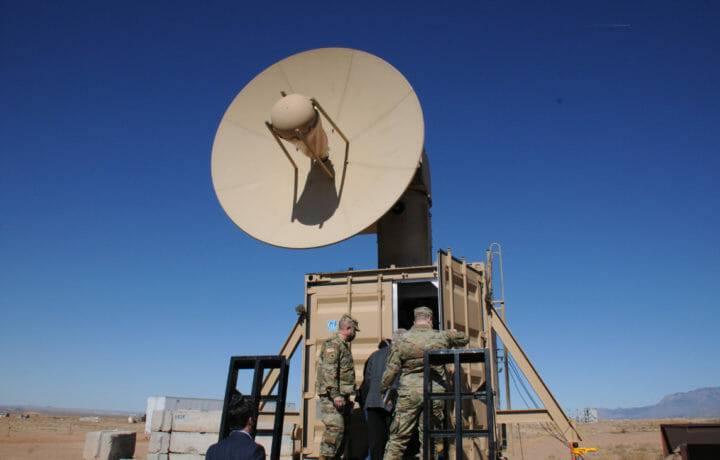Your kitchen microwave is, obviously, a tool for peaceful purposes: You use it to heat food. But the process your microwave uses to turn popcorn kernels into hot, edible popcorn is one the U.S. military is putting to work in a new line of weapons against aerial drones. These “High-Powered Microwave” (HPM) weapons shoot silent energy bursts that fry drones’ circuitry and bring them instantly crashing to the ground, and defense planners say they could neutralize swarms of drones—and eventually, bigger targets like cruise missiles and enemy communications grids—faster, at lower cost, and with much less risk of civilian casualties than is possible with conventional guns and rockets.
Why Microwaves?
Our enemies have become skilled enough at making and deploying aerial drones that U.S. forces may encounter whole multitudes of them—dozens of these machines flying together in mass formation with surveillance cameras or even weapons in tow. U.S. planners have been testing laser weapons for use against drones. And for taking down one drone or just a few drones flying together, lasers can be deadly effective.
But when you’re facing a swarm of drones, you need a weapon that can shoot wide and hit a broad swath of targets at once. A laser is a precision strike—it’s not a tool for this kind of job.
An HPM is. HPMs emit invisible electromagnetic waves that can expand to cover large stretches of the open air in front of them and any drones flying through it. The Tactical High Power Operational Responder (THOR), an HPM newly developed under the direction of the U.S. Air Force Research Laboratory (AFRL), has killed as many as 50 aerial drones at a time in field tests. The system measures about 20 feet wide and sports an antenna on its topside. Its invisible emissions shoot from this antenna and render its targets flightless in less than a second upon impact.
HPMs hold another advantage over lasers: They work better in adverse weather. Clouds or rainfall weaken lasers but have only minimal impact on microwave energy.
More HPMs on the Way
THOR is now operational at several (undisclosed) Air Force installations. And the U.S. Army is adapting the weapon system for use by its own forces: The Army’s Rapid Capabilities and Critical Technologies Office signed onto the THOR program in 2021 and will be overseeing field tests of an Army-adapted THOR prototype throughout 2023 and 2024. If systems tests go as planned, the Army’s version of THOR may go operational some time in 2026.
The Air Force, meanwhile, is moving on to a next-generation THOR-like HPM. Dubbed Mjolnir, the name of the mythical Thor’s mighty hammer, it is expected to have wider range and more drone-tracking capabilities than THOR. The AFRL awarded Leidos the contract for developing Mjolnir back in February.
High-flying HPMs
THOR and Mjolnir will be ground-based units. Startup developer Epirus, however, is taking HPM development in another direction: mounting them onto drones. The company’s Leonidas Pod will sit within an unmanned vehicle that can take off from its host base and fly toward the oncoming enemy drone swarm, meeting it on its route before it reaches the base. This will give U.S. forces the means to take enemy drones down at a greater distance. THOR, by contrast, works on its targets once they’re in a range of 0.4 miles.
The U.S. Navy, meanwhile, is looking into mounting HPMs on cruise missiles. It’s collaborating with the Air Force on the High Power Joint Electromagnetic Non-Kinetic Strike (HIJENKS), an HPM that could fit into the warhead of a missile. An aircraft will take off from a Navy ship and fire the missile so that it flies over an enemy command center building. As it nears its target location, the HiJENKS will emit electromagnetic bursts that sabotage the building’s IT networks and electric circuitry, disabling its command systems and any communications that run through the building.
The military can, of course, now destroy any building it chooses using old-fashioned missiles and bombs. But these conventional weapon strikes inevitably kill innocent people. Not so with HPMs. These up-and-coming weapons are bloodless and humane, limiting their damage and destruction to enemy hardware while sparing any human life.
Microwave Tech – just One way to Keep Pace With Adversaries
If there’s one thing the U.S. military excels at, it’s technological innovation. As our enemies’ weaponry evolves, U.S. defense innovators roll out new tools to neutralize them. HPMs are one such promising new solution. From the ground, from drones, or even from cruise missiles, they’re a promising new approach for helping U.S. forces stay ahead of unmanned aerial threats.



